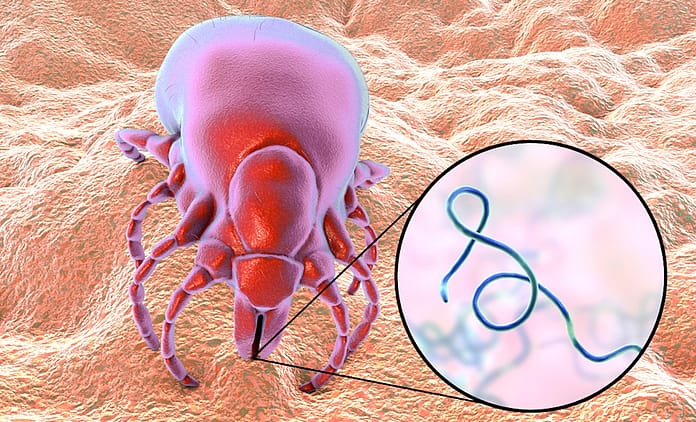Lyme disease, which is caused by a bacterium called Borrelia (Borrelia gariniAnd NS. afzeliAnd B. burgdorferietc.) and transmitted by ticks, can be persistent and dangerous if not treated in time. So far, efforts have focused on developing or improving treatments, but a team of researchers recently discovered that a known antibiotic actually has a “targeted” range of action enough to kill specific bacteria without harming animals or plants. It is prevalent in nature, and thus could make it possible to eradicate Lyme disease directly at the source, according to the researchers. The first field trials will take place next summer.
Lyme disease is a growing problem in Europe, North America, and Asia. It first causes a characteristic bull’s-eye rash and a flu-like syndrome. If left untreated, it can lead to serious long-term problems, such as Lyme arthritis or neurological disorders.
« Lyme disease is in a good position to eradicate says Kim Lewis of Northeastern University in Boston. ” We are preparing, the first field test will take place next summer Lyme disease is caused by bacteria called . Borrelia burgdorferi that hide in wild mice. Ticks that feed on these mice are infected and can infect other animals, including humans.
Hygromycin A: a target harm that has been studied for years
She is currently treated with broad-spectrum antibiotics such as doxycycline, which kill a wide range of bacteria. However, it disrupts the gut microbiome, causing symptoms such as diarrhea (sometimes over a long period of time), and can also lead to increased resistance to antibiotics.
Lewis’ team discovered that a well-known compound, hygromycin A, is completely harmless to animals and has little effect on most bacteria, but is highly lethal to spirochete bacteria such as B. burgdorferi. Spirochete bacteria have a spiral shape that allows them to burrow into tissues. They are also the cause of diseases such as syphilis. ” They are hard pathogens Lewis says.
In animal testing of the compound hygromycin, the team observed no adverse effects at any dose. ” It is exceptionally safe Lewis says. FlightPath is asking the US for the initial green light needed to test the narrow-spectrum antibiotic in humans.
Hygromycin can also be used as a treatment for syphilis, especially because this bacterial infection develops resistance to standard treatments. In addition, Lewis’ team showed that feeding mice a bait containing hygromycin can eliminate infection B. burgdorferi. In theory, releasing such a bait into the wild could eliminate Lyme disease from entire regions, if not entire countries.
High risk of spreading super bacteria
According to Lewis, a field test conducted ten years ago with a doxycycline-based bait was successful. But the widespread use of this product for this purpose is undesirable, as it may lead many microbes to develop resistance to antibiotics.
In contrast, Lewis studies indicate that it is very difficult B. burgdorferi Development of hygromycin resistance. This is because this antibiotic is similar to essential nutrients that spirochetes cannot make on their own and that they absorb using a specific carrier, so mutations that block hygromycin uptake will also deprive spirochetes of these nutrients.
Lewis says his team isn’t the first to discover the potential of hygromycin. It was studied as a potential treatment for swine disease in the 1980s, but the research was abandoned. Vaccines for Lyme disease are also in development, but eradicating the disease would be a better option.




